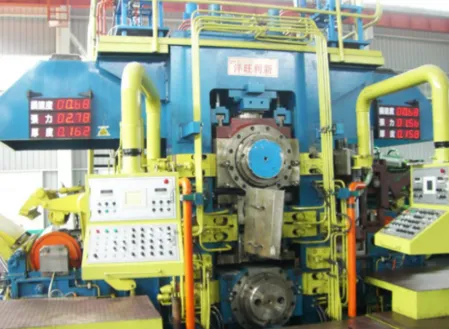
Application of Temper Mill Process in Aerospace Alloy Plate Shaping
The aerospace industry demands materials with exceptional strength-to-weight ratios, precise dimensional tolerances, and superior surface finishes. One of the critical processes in shaping high-performance aerospace alloys is the temper mill process, which refines the mechanical properties and surface quality of metal sheets. Temper mills, including specialized systems such as the 1380 temper mill and high-quality temper rolling mill, play a pivotal role in producing aluminum, titanium, and other advanced alloy sheets used in aircraft structures.

Understanding the Temper Mill Process in Aerospace Manufacturing
The temper mill process is a cold-rolling operation that imparts specific mechanical properties to metal sheets by carefully controlling their hardness, ductility, and surface finish. Unlike hot rolling, which shapes metal at high temperatures, temper rolling occurs at room temperature, allowing for tighter tolerances and improved material consistency.
In aerospace applications, aluminum alloys (such as 2024, 7075) and titanium alloys undergo temper rolling to achieve optimal strength without sacrificing formability. The process involves passing the metal through a high-quality temper rolling mill, where controlled pressure refines the grain structure, eliminates yield point elongation, and enhances surface uniformity.
Key Benefits of the Temper Mill Process for Aerospace Alloys
Improved Strength and Fatigue Resistance – Cold working in a temper mill increases dislocation density, enhancing the material’s mechanical properties.
Enhanced Surface Finish – Critical for aerospace components, where smooth surfaces reduce drag and improve fatigue life.
Precise Thickness Control – Ensures uniformity across large sheets, which is essential for aircraft skin panels and structural parts.
Reduced Residual Stresses – Minimizes distortion during subsequent machining or forming operations.
The Role of High-Quality Temper Rolling Mills in Aerospace Production
Not all temper mills are created equal. Aerospace manufacturers rely on high-quality temper rolling mills designed to handle advanced alloys with extreme precision. These mills feature:
Advanced tension control systems to prevent material stretching or warping.
Precision roll grinding to maintain consistent surface finishes.
Automated thickness monitoring to ensure compliance with strict aerospace standards.
One notable example is the 1380 temper mill, a specialized system capable of processing ultra-thin yet high-strength alloys used in modern aircraft. Such mills incorporate closed-loop feedback mechanisms to adjust rolling parameters in real time, ensuring that each sheet meets exacting aerospace specifications.
Soft Rolling Mill vs. Temper Mill: Choosing the Right Process
While temper mills focus on enhancing mechanical properties, soft rolling mills are used when maximum ductility is required. Soft rolling involves minimal cold work, preserving the metal’s formability for deep-drawing or stretch-forming operations.
However, in aerospace applications, a balance between strength and formability is crucial. The temper mill process provides this balance by imparting just enough cold work to strengthen the material while retaining sufficient ductility for further shaping. For instance, aluminum fuselage panels require temper-rolled sheets that can withstand press-forming without cracking while maintaining structural integrity under flight loads.
Technological Advancements in Temper Rolling for Aerospace Alloys
Modern aerospace manufacturing demands ever-higher precision, driving innovations in temper mill technology. Some key advancements include:
1. Laser-Assisted Temper Rolling
Combining laser surface treatment with temper rolling improves grain refinement, particularly in titanium alloys, enhancing fatigue resistance.
2. AI-Powered Process Optimization
Machine learning algorithms analyze rolling parameters in real time, adjusting pressure and speed to minimize defects and maximize consistency.
3. Hybrid Rolling Systems
Some high-quality temper rolling mills now integrate annealing and rolling in a single pass, reducing production time while maintaining superior material properties.
These innovations ensure that aerospace alloys meet the stringent demands of next-generation aircraft, where weight reduction and durability are paramount.
The temper mill process is indispensable in aerospace alloy plate shaping, providing the perfect balance of strength, surface quality, and dimensional precision. Specialized equipment such as the 1380 temper mill and high-quality temper rolling mill ensures that materials meet the rigorous standards of the aerospace industry.
As aircraft designs evolve toward lighter and more efficient structures, advancements in temper rolling technology will continue to play a crucial role. Whether through AI-driven optimization or hybrid processing techniques, the future of aerospace manufacturing depends on refining these critical metal-shaping processes to achieve unparalleled performance and reliability.
By leveraging the capabilities of modern temper mills, aerospace manufacturers can produce alloys that meet the extreme demands of flight, ensuring safety, efficiency, and innovation in the skies.
-
YWLX’s 1450mm Six-Hi Reversing Mill Goes Live in BangladeshNewsNov.24,2025
-
Adjusting Roll Gap in 6Hi Reversing Cold Rolling Mill for Thin StripNewsNov.13,2025
-
Quality Control Standards for Automatic Gauge Control in Strip RollingNewsNov.13,2025
-
Effect of Skin Pass Rolling on Metal DuctilityNewsNov.13,2025
-
Key Components of a Modern TempermillNewsNov.13,2025
-
Common Wear Patterns of Work Roll in Tandem Cold Mill OperationsNewsNov.13,2025
-
Revolutionary Skin Pass Rolling Technology for Enhanced Steel QualityNewsNov.04,2025










